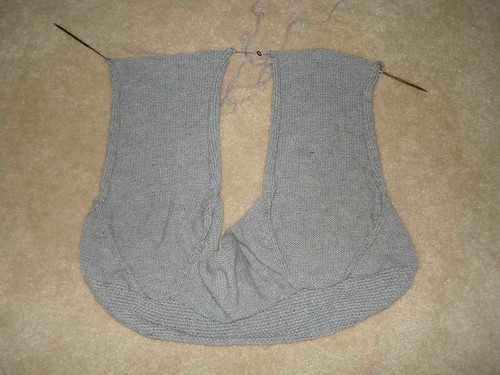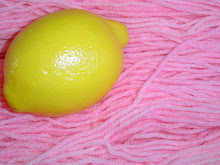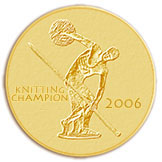Snowbird and a Great Question
Poor little Snowbird! I've lost all momentum on it because I know that I won't be able to wear it until the Fall and I'm distracted by smaller, lacier, beaded projects right now. On the other hand, when I spread it out this morning for it's photo, I can see that I'm probably within 6 inches of finishing the sleeves (that's a guess, I haven't measured). Once I finish knitting and seam the sleeves, it's just body all the way until its done, so we're really not talking about a crazy amount of knitting, I just need to motivate myself to finish it up. If I put Snowbird away until the Fall, I'll have to get myself all sorted out again before I can restart it so I'm really better off finishing it instead of putting it away. On a side note, this morning's picture was taken with a certain puppy about 2 feet away from Snowbird, laying down in a Stay (the puppy was in a Stay, not Snowbird). I think he may be starting to learn what Stay means.
Yesterday in the comments Janet A asked, "Does designing come naturally or can it be learned?" I thought this was a great question so I thought I'd give my opinion (I don't really know if there is a Yes or No answer to this) and feel free to chime in in the comments if you have an opinion too. I think that design comes both from whatever you were born with (the way your brain works, your creative spark) and what you have learned and experienced. I think different designers have different amounts of these two things (natural inspiration versus learned) and honestly they can change from day to day. There are days when I can sit down and come up with three or four design ideas in an afternoon and there are days when I can't design a stockinette stitch sock. I think there are creativity exercises anyone can do to help build up their design "muscle" and the more you practice designing, the easier it gets (I'll give you a couple below). There are also a number of books on design that will walk you through the steps (Designing Knitwear by Barbara Newton is a good one, as well as the more recent Knitwear Design Workshop by Shirley Paden which is exactly what the title says: a workshop on designing). A good stitch dictionary is also helpful when you're looking beyond stockinette (Barbara G Walker's set of 4 are some of the best out there, with the first two being my personal favorites). So while I do think that you probably need some natural ability to design, the more you practice and try to push yourself, the easier it becomes.
Here are a couple of things you can do to exercise your creativity:
- Grab a stitch dictionary and pick a stitch, any stitch. Try to figure out how many different ways you could use this stitch. What type of yarn would work for it - heavy, light, lace, fuzzy, shiny, etc. Where could you use it - cuffs, edging for lace, as a collar, in a blanket. Really think through all the ways that the particular stitch will work as a design element. You might want to actually swatch the stitch to see how it behaves - is it dense and stiff, will it work better if it's knitted tightly or loosely, is it soft and drapey, does it contract horizontally, figure out why it does these things if you can. Once you've gotten comfortable working with a single stitch, try to pull two or more stitches together as if you were using them in a single project. Remember that not only do you need to pair similar styles of stitches together (lace with lace, dense cables with other dense stitches), depending on how you're going to use them you may need to keep in mind the number of rows and stitches in a repeat of each pattern. It's easier to pair a 12 row repeat pattern with an 18 row repeat pattern than it is to match it with a 20 row repeat pattern. These kinds of things can make a difference as to how easy or difficult your project is to design as well as making it easy to knit.
- Look at designs you like and try to pick them apart. There is really only a finite number of styles of sweater design - the things that set one raglan design apart from another is the details. Figure out what makes a design special, what makes it stand out. Go through your favorites in Ravelry if you use that feature, go through your pattern stash, go through catalogs and stores and look at ready-to-wear. (Yes, ready-to-wear can be helpful both for identifying trends in style and color and for grounding you in reality. Just because you can design a gorgeous, complex sweater doesn't mean anyone is going to want to knit it and wear it. Let's face it, if we had to choose one item of knitwear in our closets that gets worn year round for all occasions, it would be a fine gauge stockinette, jewel neck pullover. Whether it's cotton for everyday, silk or cashmere for dressing up, long sleeves for Winter, short sleeves when it's warmer or sleeveless in the Summer, we all live in T-Shirts.) Figure out what the different elements are that have been combined to make the design. Try to figure out what element, or combination of them made the design stand out enough for you to buy it or "favorite" it. Knowing how to pick apart other people's designs will make it easier for you to combine elements in your own designs. (I'm not saying that you should copy other's designs, but learning from them is definitely a way of broadening the way you look at things and will help you approach your own designing in a new way.)
Labels: Cardigans











2 Comments:
And a great answer to a great question! I completely agree on exercising the design muscle - the more one can practise, the better the designs will be. And yes - a good foundation is essential - especially with garments - I think of all the variations on a theme I try on in ready to wear, and how the smallest differences in detail can dramatically change the fit.
Loving the Snowbird as well - go on - if you finish it now, it will be like you have a free gift handknit come the cooler weather!
Thanks, great answer.
Post a Comment
<< Home